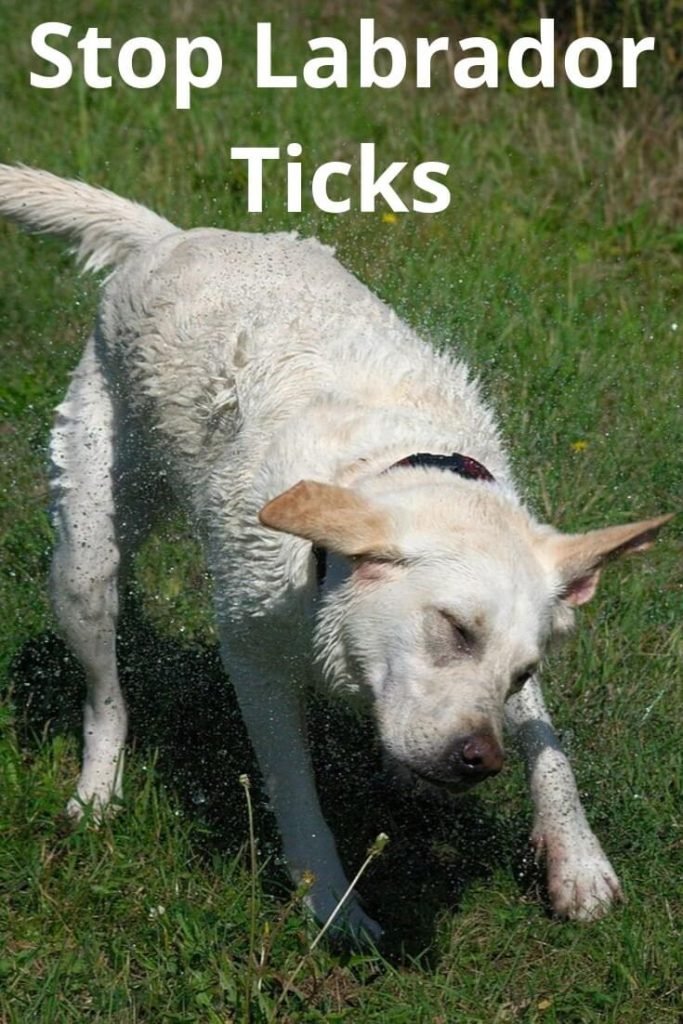Playing with your Labrador is fun. Sometimes while you move your fingers through his fur you find some bump like structures. Observe them carefully and these bumps have legs and they look like insects. These are actually Ticks and they belong to the arachnid family like spiders.
Labrador ticks can be very irritating and disgusting and are a potential carrier of diseases to your dog. These ticks feed on the blood of your dog and hence need to be removed immediately to protect your Labrador from various health risks.
Labrador ticks and removal
What does a Tick look like?
Some owners can identify labrador ticks very easily, but for new dog owners, it is a bit difficult task to identify them, especially when they are small. Many owners ask me questions like what does a tick on my dog look like? or how to identify a tick on a dog? I will explain to you clearly how to identify ticks on Labrador.

Identifying the ticks on labrador when they are small is very important because the longer they stay on your dog the more chance of spread of infections.
1. Groom your dog regularly to identify any bump like structures
2. Ticks are round and oval shaped, they are attached to your dog’s skin
3. They might be greyish black, brown, pale yellow or pinkish in colour
4. Do not confuse skin tags with ticks, you can always notice their legs attached around the skin if it is a tick
Tick removal process
Ticks removal is not a difficult task but has to be done carefully. Pulling the tick with your hand and squeezing it in a hurry is not a good idea as it can expel infectious toxins into your dog’s bloodstream. There are also chances that these ticks can spread infections to you. Gear up with some tools before you start removing ticks on your dog.
Remember one thing, it is very important to remove the ticks as soon as possible after being affected, the longer it stays on your dog the greater is the risk of infection for your dog.

Tools for tick removal
1. A pair of latex gloves
2. Tick removal tool such as Tweezers
3. Rubbing Alcohol
4. Cotton
5. Mild soap for cleaning
How to safely remove a tick from a Dog
1. Wear the pair of gloves to prevent the spread of infections
2. Use the Tick removal tool and hold it close to the skin of your dog. Keep it as close as possible. Hold the Tweezer and twist it slowly until the tick is detached from your dog’s skin.
3. Take care that the tick is not smashed as it can expel infectious toxins into your dog’s body.
4. Place the removed tick in a small container of alcohol. Do not throw the tick in the drain as ticks can survive in water.
5. Clean the area of the tick bite with mild soap and water.
Different types of ticks on Dogs
Ticks can be broadly classified into two types, they are
1. Hard-shelled ticks with a hard outer shield and looks like a flat seed. Hard ticks are more likely to infect animals and people than soft ticks
2. Soft-shelled ticks with softer, rounder bodies and looks like a bulged seed.

Tick diseases in dogs
There are 900 species of ticks approximately and they prefer to stay in warm and humid areas. Ticks are a nuisance to your dog as they cause itching and irritation in the area of the bite. But the major problem is that they are a carrier of serious vector-borne diseases. These diseases sometimes can be fatal to your Dog. The major tick diseases that may affect your labrador are
1.Lyme Disease
Lyme disease is zoonotic that can spread to both humans and pets. It is found globally and transmitted through Deer-tick. It is difficult to spot Lyme disease in your dog as symptoms are not clearly visible. Some symptoms include lameness, reluctance to move and fatigue.
It is important to contact your vet as soon as possible as the later stages of Lyme disease cause complicated health issues such as Kidney disease, diarrhoea, vomitings and swollen lymph nodes near the site of the bite.
2. Ehrlichiosis
Ehrlichiosis is a tick-borne bacterial infection that affects the white blood cells. It is a dangerous disease that could make the health of your dog worse. Symptoms include low appetite, anaemia, bruising and bleeding which tends to be abnormal.
3. Anaplasmosis
Anaplasmosis is transmitted by the brown dog tick. The bacterial infection occurs in two forms depending upon whether the infection occurred to white blood cells or blood platelets. The symptoms may be similar to ehrlichiosis but also include lameness, lethargy and joint pain.
4. Rocky Mountain Spotted Fever
The Rocky Mountain Spotted Fever appears suddenly and the symptoms exist up to two weeks. This disease can be fatal if not treated in the early stages itself. This bacterial infection affects the small blood vessels and this disease can affect both humans and pets.
Symptoms include abnormal bleeding, anorexia, fever, reluctance in going out for a walk. Mostly the overall activity level of your dog gets decreased.
Ticks prevention in Labradors
1. Cut the source of Ticks
It is easy to prevent ticks rather than removing them later. Where do Ticks come from? Where do they live? Ticks prefer warm and humid climates, they live and thrive in thick, dense vegetative areas. If you have a lawn full of grass and shrubs there are pretty good chances that ticks might create their homes. Do you want to prevent ticks completely?. Clean the decaying leaves, long grasses and keep your garden area well-groomed.

My lab puppy was heavily infested with ticks during his 5th month, after his ticks treatment the first thing i have done to prevent ticks is trimming my garden completely. After trimming my garden and taking certain precautions the nuisance of ticks did not arise again for my lab.
2. Avoid certain outdoor areas
It is a happy experience to go out along with your lab either for a walk or for a trek. But is your Labrador safe? Whenever your dog roams in certain areas, it is highly susceptible to tick infestation. What are these kinds of areas?

Ticks prefer a certain type of habitat to live in, such as moist shrubs, wooded vegetative areas, thick meadows, bushy grasses, overgrown grasses, areas with decaying leaves. Strongly avoid all these kind of areas. Even when you go out for a walk with your dog, make your dog walk on the road trail. Avoid all kinds of ecosystems with Tick habitats.
3. Check your labrador frequently
Inspect your lab whenever it goes out for a walk in the woods. Check for signs your dog has a tick. Gently move your fingers through your dog’s fur and inspect for any kind of irregular bumps, these bumps might be ticks. Especially check certain areas of your dog such as inside the ears, around the eyes, under the collar, between the front legs, between the back legs, between the toes. These are the areas where tick infestations are mostly found.

Check these areas properly and remove any tick found as soon as possible to avoid further infections. Comb your dog regularly to check if any ticks are present.
4. Prefer to keep your dog indoors
In cases of tick infestations, prefer to keep your dog indoors along with you. Leaving your dog in the garden increases the chances of tick infestations. I prefer to allow my dog on my bed rather than leaving it in the garden. It is not a good idea to keep your dog indoor always, but it is a wise option in order to protect your dog from infectious ticks.
Side effects of a tick bite on a dog
All ticks are not potential carriers of diseases. Ticks can be generally harmless but can cause various side effects after its bite. These side effects include
Loss of Blood.
Anaemia.
Irritation and Itching.
Skin patches due to heavy scratching.
Infection on the skin.
Inflamed bite area
Do not neglect these symptoms and side effects of a tick bite. Take your Labrador to a Vet and treat your dog as soon as possible to avoid further complications of infection.
“We would Love to hear from You. Ask your Questions and Share your views in comments”
To Unlock Your Dog’s Hidden Intelligence Click Here
To Train Your Dog to Behave Obediently With Simple Games Click Here


